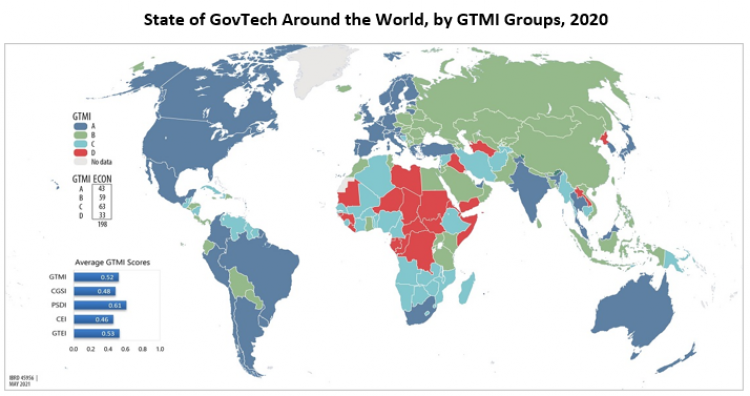GovTech in the age of COVID: Urgent need and uneven progress

GovTech Maturity Index: The State of Public Sector Digital Transformation
The COVID-19 pandemic isolated many at home and disrupted the normal operation of governments around the world. The crisis exposed the urgency of adopting the latest technology to promote simple, efficient and transparent governing, centered around the needs of citizens.
GovTech – the use of the latest technology to modernize the public sector -- has great potential to deliver on the promises of the digital age by improving core government systems and services to citizens . A new report, The GovTech Maturity Index: The State of Public Sector Digital Transformation, provides a comprehensive review of how far 198 nations have come and still need to go. The study specifies areas for improvement so that policy makers and their advisers can make informed decisions on how to tackle specific challenges to advance public sector modernization. Practitioners will also be able to use it as a resource to design new digital transformation projects.
The GovTech Maturity Index provides a global snapshot of GovTech maturity, along with a diverse set of good practice examples and entry points for enhancing technology. It is a composite index that uses 48 key indicators and is comprised of four sub-indices:
- The core government systems index (CGSI) captures the key aspects of a whole-of-government approach, including government cloud, enterprise architecture and integrated financial management information systems.
- The public service delivery index (PSDI) uses existing data from the UN Online Service Index as well as new indicators on online portals, e-filing services, e-payment capabilities, among others.
- The citizen engagement index (CEI) measures aspects of public participation platforms, citizen feedback mechanisms, open data and open government portals.
- Finally, the GovTech enablers index (GTEI) captures strategy, institutions, laws and regulations, as well as digital skills, and innovation policies and programs, to foster GovTech. All data at the economy level can be found in the GovTech dataset.
The 198 economies were grouped into four categories based on their GTMI score, from A (GovTech leaders) to D (minimal focus on GovTech).

Source: World Bank data (198 economies)
The global map is striking for several reasons. Government entities leading the GovTech agenda exist in 80 economies out of 198 reviewed. While the 43 Group A economies are dispersed across the world, the 33 Group D economies are mostly in the Africa region. The majority of economies fall into the B and C Groups, 59 and 63 respectively, revealing significant GovTech improvement opportunities.
On average, countries in the A Group have the highest index score, as expected, and the gap between A and D is wide, as presented below. Similarly, a substantial gap exists between the average GTMI scores of high- and low-income countries. These observations are consistent with the findings of the World Development Reports for 2016 and 2021, which showed that the digital divide continues to grow, especially in low- and middle-income countries. The COVID-19 pandemic laid bare both persistent social inequalities and this increasing digital divide. Many middle- or low-income and rural communities, including those in large urban areas, still lack reliable and affordable access.

The report also reveals some trends in digital government strategy and approaches to transformation. Within the last five years, about 120 countries have developed new digital government strategies that are more focused on the GovTech agenda and promote a whole-of-government approach to public-sector modernization as well as improved accessibility to online services, multifunctional citizen participation platforms, and a sustainable GovTech ecosystem. These advanced capabilities are more visible in A and B Groups; some countries in C and D Groups, such as Angola, Cuba, Guatemala, Nigeria, and Senegal, also have focused on improving data governance, digital skills, data literacy and public sector innovation. The study presents 22 good-practice cases covering all regions and income levels in relation to GovTech focus areas.
These findings suggest areas of action for World Bank client countries. Since 2018, when the World Bank launched the GovTech Global Partnership Initiative, supported by the governments of Austria, South Korea, and Switzerland, the portfolio of GovTech projects has grown significantly , with projects in every region from Argentina to Vietnam. These projects target improving several aspects of GovTech: those just beginning their digital transformation journeys may focus on connectivity, strategy, policy, and platforms; while more advanced countries may be focusing more on innovative data applications, artificial intelligence for proactive service delivery, and big data for better planning and policymaking.
The report shows that countries have numerous opportunities to enhance current systems, services, and platforms for the benefit of their institutions and citizens. The data and analysis can inform country level dialogue to further the GovTech agenda. For the next iteration, the methodology will be refined and the GovTech dataset will be updated to capture ongoing developments and trends.
Watch the replay from the live launch event.
Read the report -- GovTech Maturity Index: The State of Public Sector Digital Transformation
For more information, visit the GovTech webpage.
